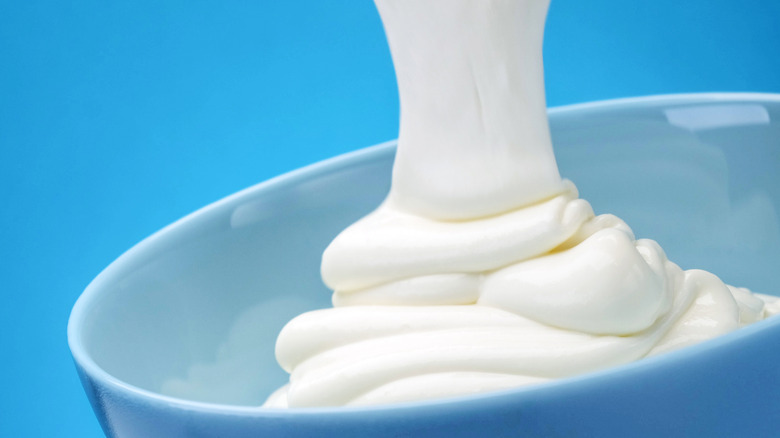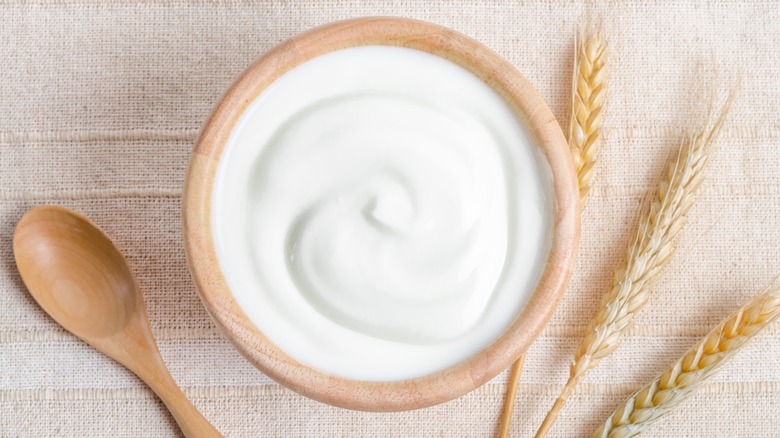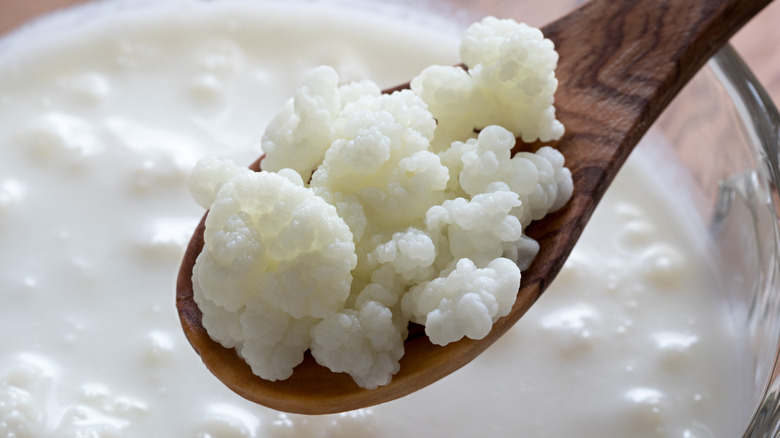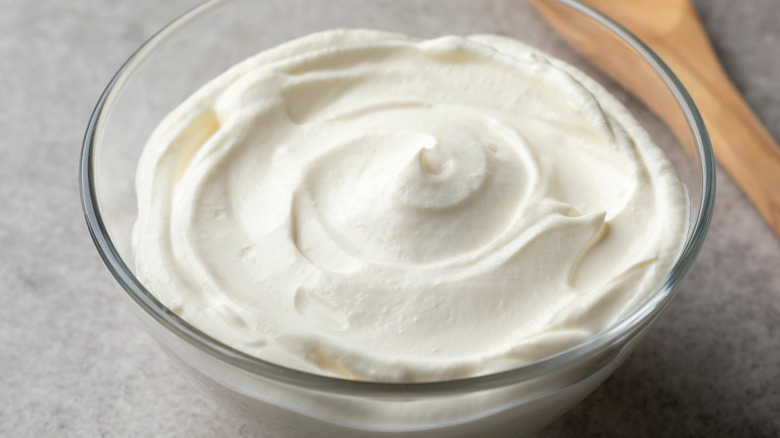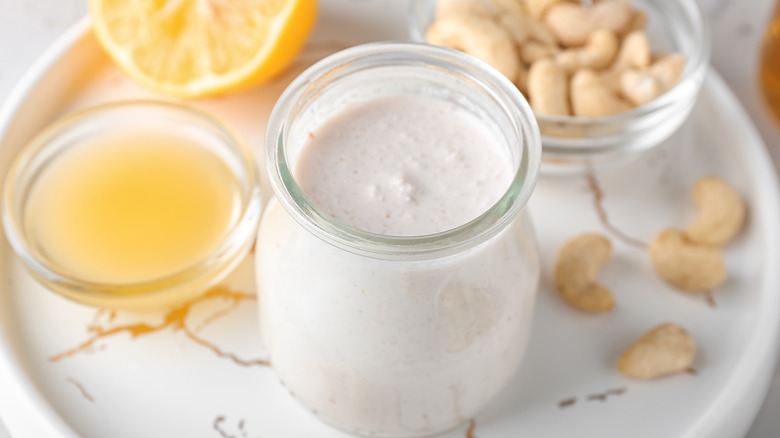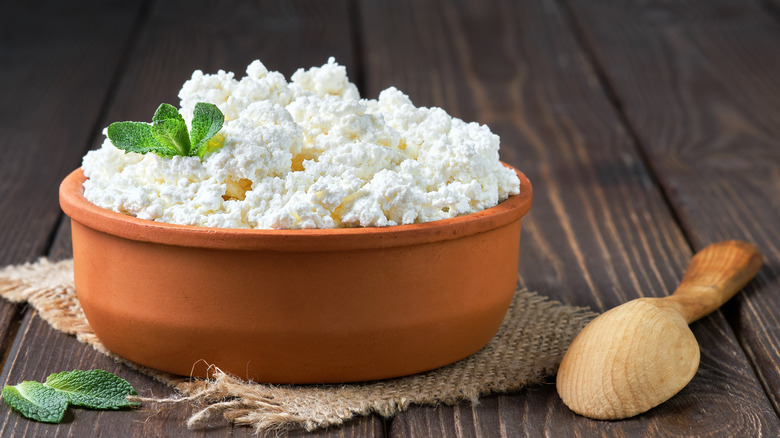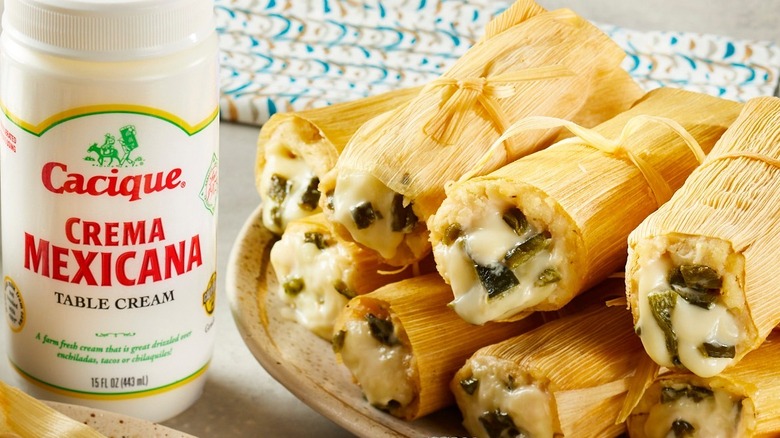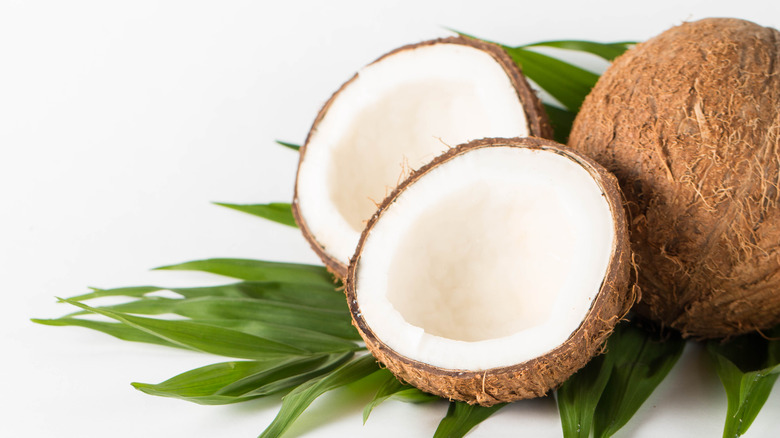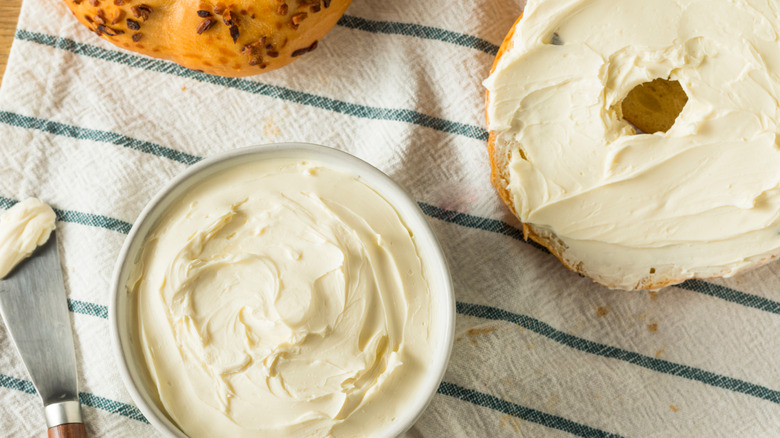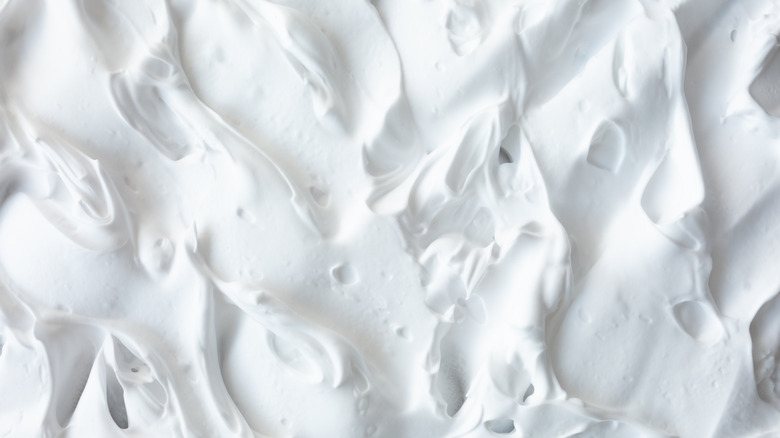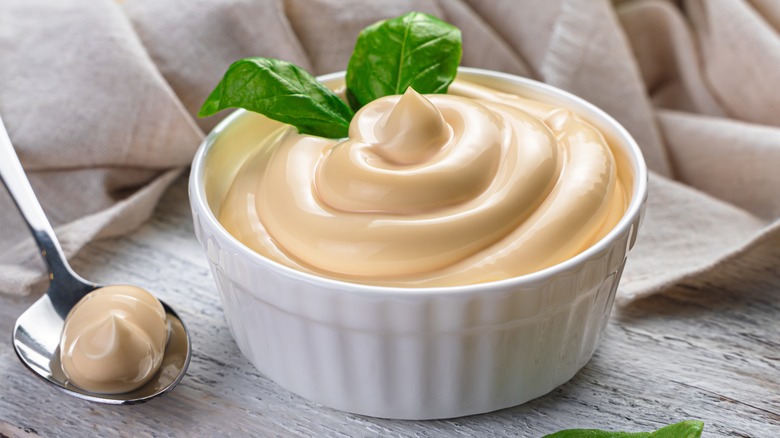The Absolute Best Sour Cream Substitutes
If you think about it, sour cream might not have the best name. Let's be honest, the word "sour" doesn't exactly paint the best picture when it comes to dairy products. I mean, who wants a big, tall glass of sour milk? But it doesn't seem like sour cream's name has been a problem for it. As The Spruce Eats points out, it's a regular go-to ingredient that's found its way into snacks, main courses, and even desserts.
Yes, sour cream is versatile. Want to use it on crunchy raw vegetables? No problem, as sour cream is safe to eat uncooked. Need to make a cake? A little sour cream in the batter can give your sweet creation a nice soft texture. Want to add a little tang and thickness to your sauce? Well, while sour cream can be a good ingredient for many dishes, the heat from cooking (but not baking) can make it curdle. With that said, it's often recommended to add sour cream to foods like sauces when they are close to done cooking in order to minimize its exposure to the heat.
Although it has many uses, that doesn't mean sour cream is irreplaceable. What you choose to swap it with, however, is very much dependent on the recipe and your personal preferences. So, you might want to try experimenting with the following ingredients and see which ones are your favorite go-tos for when sour cream isn't on the menu.
Greek yogurt
While yogurt in general can be used instead of sour cream, according to The Kitchn, Greek yogurt made from whole milk is a particularly good substitute. This is not only because sour cream and Greek yogurt taste similar, but also because they have a comparable thick texture. As Bon Appetit explains, Greek yogurt has a higher density than other yogurts due to how it's made.
When we think of foods that need to ferment, our minds tend to go to drinks like beer or kombucha. However, fermenting is a key step to making Greek yogurt. In fact, Greek yogurt starts as what we would think of as "regular" yogurt. The main difference is that more whey has been drained out of Greek yogurt, giving it the thicker texture that makes it so interchangeable with sour cream. However, there are some drawbacks.
Yogurt is even more sensitive to heat than sour cream because of its lower fat content (per The Kitchn). So if you're adding yogurt to a sauce, for example, you're going to need to either dial down the heat or mix it in after you've removed the sauce from the heat entirely. Also, yogurt can change the texture and flavor of baked goods in different ways than sour cream. But with that said, you can add yogurt to uncooked sour cream items like salad dressings and dips without altering anything else in the recipe.
Kefir
Although kefir might seem like a relatively new product, it's believed that it's been around for hundreds of years, according to WebMD. And while cow's milk is a possible ingredient for kefir, it can also be made from sheep's milk or goat's milk. The main thing all types of kefir have in common, however, is that the milk is fermented, which makes it a good source of probiotics.
Now, if fermenting sounds familiar, it should. As WebMD points out, Greek yogurt is also made through fermentation. Thus, it's not surprising that kefir shares some similarities with Greek yogurt in terms of taste, making it a good substitute for sour cream. But Greek yogurt is much thicker than kefir, so kefir has a different consistency than sour cream. Not to worry, though, because as Epicurious points out, kefir works well in baking recipes that call for sour cream, as well as in dressings. So, no worries about heat when you use it to give pancakes a unique flavor and texture. Basically, as long as runniness isn't a concern, you can use kefir in place of sour cream.
Besides being a good substitute for sour cream, kefir's probiotic quality might be good for health issues like constipation, per WebMD. However, while probiotics like the kind found in kefir can help promote good digestive health, they can also cause bloating and gas.
Crème fraîche
If you ask Google Translate what the phase "crème fraîche" means in English, it will tell you "sour cream." However, that's not the whole story. As The Kitchn points out, crème fraîche originally came from unpasteurized cream. If you live in the U.S., though, the crème fraîche you find in the supermarket is pasteurized and specially fermented.
Okay, but is it different from sour cream? Well, despite what Google Translate says, it is. For one thing, crème fraîche has roughly 10% more fat than sour cream. Because of this, it's a great substitute for sour cream in foods like sauces, since sour cream curdles when cooked (but not when baked). Also, manufacturers sometimes add thickeners to sour cream like vegetable enzymes and gelatin. On the other hand, crème fraîche contains no thickeners, yet is thicker than sour cream. So, dolloping it on a baked potato works very well. However, that doesn't mean there aren't a couple of drawbacks when you swap out crème fraîche for sour cream.
Although the two are very similar, sour cream has a tangier taste than crème fraîche, which has a richer flavor. And then, there's the price tag. Yes, crème fraîche is more expensive than sour cream. However, if it gives you the results you're looking for, it might be worth the extra cost.
Vegan sour cream
Now, you might be thinking this next item is cheating since the words "sour cream" are in its name. Despite that, however, sour cream and vegan sour cream aren't the same. As Master Class explains, vegan sour cream doesn't contain dairy. In fact, vegan sour cream can be adjusted to fit dietary needs like food allergies and intolerances.
Vegan sour cream can be made from either cashews or tofu instead of dairy cream. So, if you're cooking for someone with a nut allergy, you can opt for the tofu. On the other hand, if you or someone else has celiac disease and cannot have gluten, then you can use the cashews. The trick is to combine either cashews or tofu with something acidic, so your vegan sour cream will have a similar flavor to regular sour cream. You can use either apple cider vinegar or lemon juice to give your vegan sour cream that tanginess (per Master Class).
While vegan sour cream can be used in both hot and cold dishes like traditional sour cream, there are a few things to keep in mind. First, while vegan sour cream is tangy, that doesn't mean it tastes exactly like dairy-based sour cream. Also, making vegan sour cream is a more complex process than making traditional sour cream, and thus requires more equipment. For example, you'll need either a food processor or a high-speed blender to make vegan sour cream, but not dairy-based sour cream.
Cottage cheese
You probably know that there is a wide variety of yogurts on the market, but did you know that there's also quite a few types of cottage cheese? As Healthline explains, while curds from pasteurized milk are used to make cottage cheese, that doesn't mean the curds can't be different sizes. For example, they can be large, small, or somewhere in between. You can also have cottage cheese that's whipped or creamed. And when you combine its different possible consistencies with its mild flavor, you get the basis for a sour cream substitute.
Of course, to make cottage cheese really work as a stand in for sour cream, you'll need to add a couple ingredients. According to Tastessence, there are some variations of this recipe you can use, depending on your personal preference. However, besides cottage cheese, you must add lemon juice to help recreate the unique flavor of sour cream. As for the third ingredient, you can choose between low-fat yogurt, milk powder combined with cold water, or skim milk.
In addition, it's important to calculate how much of this substitute you'll need in order to measure out the right amount of each ingredient. For example, if you need a cup for the recipe, then you'll also need a cup of cottage cheese, and either a teaspoon of lemon juice with a quarter cup of low-fat yogurt or a tablespoon of lemon juice with two tablespoons of skim milk (or the milk powder/cold water combo).
Mexican crema
If you're looking for something tangy like sour cream but also rich like crème fraîche, this next substitute might be the perfect ingredient to add to your kitchen. According to Chili Pepper Madness, Mexican Crema's flavor is like a combination of sour cream and crème fraîche. Made from buttermilk, lime, and salt, Mexican crema isn't as thick as crème fraîche, which can be beneficial if you want to cook with it.
Mexican crema has a higher fat content than traditional sour cream. It's also less likely to curdle in things like sauces and soups. And if you're cooking for someone with a sensitive stomach, it's not as acidic as sour cream. Plus, it takes a bit of the heat out of chilies. This ability to balance out spicier dishes makes it a common ingredient in traditional Mexican dishes like nachos, tacos, enchiladas, and tortillas. However, don't limit yourself. If the recipe calls for sour cream, Mexican crema could make a good substitute.
Although Mexican crema is used to top foods, keep in mind that it is thinner than crème fraîche (per Chili Pepper Madness). In fact, the site says sour cream is "a more relevant choice" as a food topping. So, you want to think about the results you're going for with a particular dish. If a thicker dollop is better, then you might want to consider a different substitute.
Buttermilk
Although buttermilk was at one time the byproduct of churning butter by hand, today it's a type of fermented milk product, according to the Food Network. And it's not hard to see why it can be a good stand-in for sour cream. Not only does it have a thicker consistency than regular milk, but it also tastes a bit like another sour cream substitute on this list: yogurt.
Although buttermilk is thick, sour cream still tends to be thicker (via The Kitchen Community). This isn't a problem, though, if you get back to buttermilk's roots. Remember, people originally made buttermilk when they churned butter, so you can thicken modern buttermilk by adding butter to it. In fact, The Kitchen Community says that a third of a cup of butter should be enough to change your buttermilk's consistency to something at least close to sour cream's. Of course, you might need to adjust this amount, depending on how much buttermilk you need for a recipe.
Once you've gotten your buttermilk to the level of thickness you want, you'll find that it's useful for a variety of dishes. It's particularly well-suited for baked goods because of its acid content, per the Food Network. For example, have you ever wondered why buttermilk pancakes seem so much fluffier and thicker than regular pancakes? It's because the acid in buttermilk helps batter rise better and makes the consistency softer, due to the way it interacts with the natural gluten in pancakes.
Coconut cream
On the surface, this next food might seem like an odd choice for a sour cream substitute. After all, coconuts aren't tangy or sour. But not so fast. With a couple of ingredients, you can transform coconut cream into a good substitute for sour cream (via My Frugal Home).
Before we go any further, it's important to understand the difference between coconut cream and coconut milk. As Bon Appetit explains, both products contain water, coconut, and (depending on the manufacturer) guar gum. However, coconut cream is thicker than coconut milk because it has more fat. In fact, you can technically get coconut cream from a can of coconut milk. How? Well, have you ever heard the expression, "cream rises to the top"? That's literally what happens with coconut milk when you put it in the fridge, according to My Frugal Home. Just don't expect a large amount of cream in a single can of coconut milk.
Whether you decide to buy coconut cream or separate the cream from coconut milk, you can turn it into a sour cream substitute by adding either lemon juice or vinegar. Although it's recommended to add a tablespoon of either the juice or the vinegar for every cup of coconut cream, My Frugal Home recommends tasting it and adding salt and possibly more vinegar or juice. In other words, how much you want to change the flavor of the coconut cream depends on your preference.
Cream cheese
While you might think of cream cheese as a breakfast food (a la bagels and cream cheese), it's actually an extremely useful substitute for sour cream. This isn't surprising, since both are fermented dairy products. However, as the Blog Chef explains, cream cheese might have two extra ingredients: salt and lactic acid.
Because they're fermented in similar ways, cream cheese has a milder yet comparable flavor to sour cream. It also contains more fat than sour cream, and tends to be denser and thicker. This, of course, comes with some pros and cons. While you might have an easier time spreading sour cream on something, cream cheese can add a level of moistness to a recipe. However, it's this higher density that makes cream cheese more difficult to use for baking than sour cream. So, you might want to thin cream cheese if you're planning to cook with it. Fortunately, there's a simple way to adjust cream cheese to meet your culinary needs.
A little buttermilk or milk can thin cream cheese and make it an even better substitute for sour cream. The general rule is to blend three tablespoons of milk or buttermilk with ¾ cup of cream cheese. However, you might want experiment with those measurements, depending on your needs for a particular recipe.
Heavy whipping cream
If you research heavy whipping cream online, you might notice that a different term comes up: heavy cream. Well, not to worry, because as Food52 explains, heavy cream and heavy whipping cream are the same thing. What it comes down to is milk fat content. According to the FDA, as long as a product has 36% milk fat or more, it's a good substitute for sour cream, whether it's called heavy cream or heavy whipping cream. However, that doesn't mean you can just throw it into a recipe as is.
Per Southern Living, it takes both time and additional ingredients to transform cream into a suitable stand-in for sour cream. Plus, you don't want to add all the ingredients at once. You start by whisking either one teaspoon of lemon juice or distilled white vinegar with one cup of cream. Then, get your kitchen timer out, because you're going to want to set that mixture aside for 10 minutes. After that, you'll need to mix in a quarter cup of whole milk to complete your homemade sour cream substitute. Well, almost complete.
To really give the bacteria in the lactic acid in your concoction a chance to work its magic, you need to cover the mixture with a cheesecloth held in place by a rubber band and let it ferment for 24 to 48 hours at room temperature. Afterward, you should chill it.
Mayonnaise
When it comes to sour cream substitutions, you definitely don't want to say "hold the mayo" for this next one. As HowStuffWorks explains, mayonnaise was created in 1756, and is a combination of egg yolks, oil, seasonings, and either vinegar or lemon juice. And, yes, it can be a good stand-in for sour cream.
According to Our Everyday Life, the Colorado State University Extension states you can swap in an equal amount of sour cream for mayonnaise. But for mayo to take the place of sour cream in a recipe, you need to combine it with heavy cream and plain yogurt. Specifically, you want an equal amount of all three of these ingredients to be present in order to create a flavor and consistency that's comparable to sour cream. In addition, you'll need to either whisk them together or use a blender to ensure that they're properly combined.
While using mayonnaise can help you create a good substitute for sour cream, you do need to be careful about one thing. As HowStuffWorks cautions, since mayo contains egg yolks, there is the possibility of contracting salmonella from it. Now, manufactured mayonnaise has an expiration date to help you avoid this health issue. But if you make it at home, you really want to be sure that the eggs you use are as fresh as possible.
